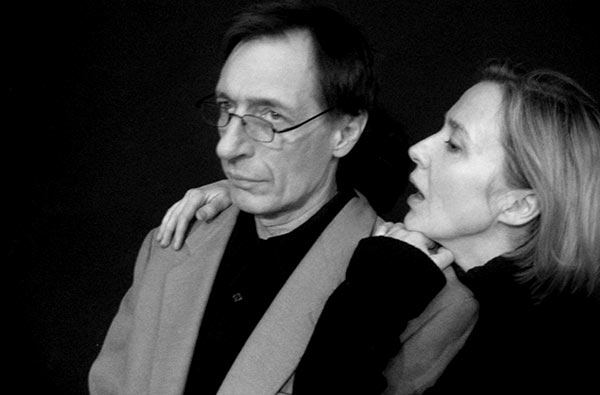|
First up in this intriguing evening of theatre was the longer of the two plays-- “The Lover” by Harold Pinter. Pinter was born in East London in 1930, and is most certainly one of our greatest, and most prolific modern playwrights. He falls into the same category of innovative and seminal playwrights as William Inge, Eugene O’Neill, Thornton Wilder, Edward Albee, Tennessee Williams, Samuel Beckett and Arthur Miller. Pinter’s work is unfailingly difficult to perform and stage—it is ephemeral and brutal at the same time. It is full of sexual ambiguity and obsession.
“The Lover” is an intricate pas-de-deux where the husband and wife have created a world defined by role-playing. The couple assume different identities in order to excite, torment and control each other. The writing lures the audience into a virtual prison of emotions—a world where things take a decidedly nasty turn as passion turns to rage. Somehow, despite the repugnant behaviour they display, the couple remain sympathetic characters.
John Evans is a commanding presence. As the male character “Richard/Max”, he fearlessly tries to push his reluctant wife towards the truth of their existence, while she attempts to cajole and manipulate him into continuing their psychosexual role-playing games. There is even the mention of the unseen “children in boarding school” that the couple allegedly has. It is never clear whether the children are real physical beings, or if they are an Albee-esque creation (as in “Virginia Wolf”), a barometer to illustrate to us how deeply the characters have plummeted into their self-induced fantasy world.
Throughout it all, Evans elegantly maintains an equilibrium of honesty and unpredictability in his dual roles. Both actors are unafraid of the Pinteresque language and the obvious Britishisms of the text. My old acting teacher used to say, “Playing Pinter is all about the spaces – the full silences between the characters”. Evans and Bazinet, seem to have been directed to plow through the spaces, so to speak, but even so, they have both captured the rhythm of Pinter’s dialogue. Brenda Bazinet is exceptional as Sarah/The Woman, bringing to the role both fragility and steel. In fact, the work of Evans and Bazinet could be likened to an “Apache Dance”—straight from the Pigalle in Paris—sexy and scary all at once.
“The Lovers” is also something of a time capsule piece – full of the influences and elements of 1962, the year that it was produced. The characters have no way of seeing into the future, past their reality of social regimentation, scotch, wife-swapping, Dwight D. Eisenhower and Seconals. Soon the social revolution will be underway… bringing with it Beatle mania, the Civil Rights movement, the pill, social drug use and eventually the Hippie era and “free love”.
It would have been so much more visceral if the music could have depicted the atmosphere of early 60’s with all of it’s longing to break social mores. The music should really have been drawn from the jazz that was being created at the time. Early Miles Davis or John Coltrane would have set the scene much more effectively than the original music of Evelyn Datl, who seems to have been heavily influenced by Mike Oldfield, composer of “Tubular Bells” (the repetitive and familiar theme from “The Exorcist”). Also, the set itself was a bit of a disappointment. It was mainly comprised of cheap looking plastic blinds (apparently from the discount bin at Canadian Tire). The blinds were both horizontal and vertical, the horizontal blinds of the “bedroom” were a thinly veiled metaphor for the emotional “jail” in which the characters have imprisoned themselves. At one point the characters deliver dialogue “at” the audience, through the jail-blinds, creating a pretty odd demolition of the fourth wall. Perhaps a real bed in the bedroom would have helped our suspension of disbelief.
The second offering of the evening, was the eminent Luigi Pirandello’s “I’m Dreaming, But Am I”. Pirandello was born in Italy in 1898, and wrote continuously until his death in Rome in 1937. He spanned the centuries, won the Nobel Prize for literature in 1934, and is certainly among the hierarchy (along with playwrights such as August Strindberg) of modern theatre. The play itself is a brief haiku of a play, and symbiotically with the “The Lover”, also explores many of the same themes, including dishonesty, greed and infidelity, with a big dose of male and female dominance issues, class distinctions, and the type of money problems that can eat away at the fabric of a marriage. Again, Evans and Bazinet burn bright as the passionate couple who may (or may not) be caught in some sort of temporal distortion. The only flaw in this jewel of a presentation was the set design. Long panels of taupe mesh like fishing nets continued to trap the actors who also struggled with a twirling bed, à la “The Wizard of Oz”. Call me old-fashioned, but I don’t believe that actors should have to battle the scenery. Although The Artword is a dead hung space, with no capability for flying sets in and out, it still seems as if set designer Behzad Adineh could have constructed a more functional and creative environment for this play, and these magnificent actors.
All things considered, this was a superb evening of all-too-rarely performed theatre, with truly mesmerizing and inspiring performances by John Evans and Brenda Bazinet. A must see for any theatre enthusiast.
|


